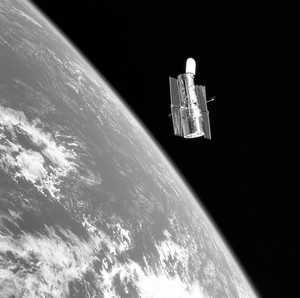A telescope used to take pictures from space, avoiding the difficulties arising from the earth’s atmosphere. These pictures give important information on many aspects of astronomy and cosmology. The Hubble Space Telescope (named after Edwin Hubble) was launched in 1990 by the National Aeronautics and Space Administration (NASA) of the USA. Since a defective mirror was corrected in 1993, the scientific results obtained have included: (1) measurements of the Hubble constant and hence the age of the universe; (2) evidence for a black hole at the centre of a galaxy; (3) evidence that in several cases a quasar is not surrounded by a galaxy; (4) pictures of fragments of the comet Shoemaker–Levy 9 crashing into Jupiter; and (5) pictures of some of the most distant galaxies known, which indicate the need for changes in theories of the evolution of galaxies.
https://www.nasa.gov/mission_pages/hubble/main/index.html The home page of the Hubble Space Telescope
A 2.4-m reflector built by NASA and ESA, launched in 1990 April. It orbits at an altitude of about 600 km. An initial servicing mission by astronauts in 1993 December was necessary to install additional optics to correct the telescope’s spherical aberration, caused by an error in manufacturing the main mirror. Subsequent servicing missions took place in 1997 February, 1999 December, and 2002 March, during which astronauts installed improved detectors and replaced the telescope’s solar panels. After the fourth servicing mission, HST’s scientific instruments consisted of the Advanced Camera for Surveys (ACS), the Wide Field and Planetary Camera 2 (WFPC2), the Near Infrared Camera and Multi–Object Spectrometer (NICMOS), and the Space Telescope Imaging Spectrograph (STIS). A fifth and final servicing mission took place in 2009 May, installing the Wide Field Camera 3 (WFC3) and the Cosmic Origins Spectrograph (COS), as well as repairing existing instruments. WFC3, which replaced WFPC2, can detect a wider range of wavelengths, from infrared to ultraviolet, than its predecessor. HST is controlled from NASA’s Goddard Space Flight Center. The Space Telescope Science Institute plans the telescope’s observing programme and collects its data.
 http://www.nasa.gov/mission_pages/hubble/main/index.html Official mission website.
http://www.nasa.gov/mission_pages/hubble/main/index.html Official mission website.https://www.spacetelescope.org The European Space Agency’s HST website.
http://spaceflight.nasa.gov/gallery/images/shuttle/sts-125/html/s125e011835.html
HST is one of NASA's most successful and long-lasting science missions. A space-based astronomical observing facility, launched in April 1990 and orbiting the Earth at an altitude of 610 km. It consists of a 2.4-m telescope and four complementary scientific instruments, is roughly cylindrical, and is 13 m long and 4 m in diameter, with two large solar panels. The HST is a cooperative programme between NASA and the European Space Agency (ESA).
Before the US$2.5 billion HST could reach its full potential, a flaw in the shape of its main mirror had to be corrected in 1993 by astronauts aboard the space shuttle Endeavour. By October 2003, the telescope had produced about 500 000 images, and had been serviced by astronauts four times. NASA announced in 2004 that it would cancel future servicing of Hubble, which will cause it to cease operating in a few years. This was a financial decision, following US president George W. Bush's announcement in January 2004 that astronauts will be returned to the Moon in 2020.
To date, HST has made more than 1.3 million observations. It has beamed hundreds of thousands of images back to Earth, shedding light on many of the great mysteries of astronomy. Its gaze has helped determine the age of the universe, the identity of quasars, and the existence of dark energy. Among its many discoveries, Hubble has revealed the age of the Universe to be about 13 to 14 billion years, much more accurate than the old range of anywhere from 10 to 20 billion years. In December 1995 the HST was trained on an ‘empty’ area of sky near the Plough, now termed the Hubble Deep Field. In 2002 an Advanced Camera for Surveys (ACS) was installed, and in 2004 it revealed the deepest view ever of the universe, showing galaxies formed shortly (700 million years) after the Big Bang. It discovered that gamma-ray bursts occur in far distant galaxies when massive stars collapse. In August 2017 it contributed critical observations of a never-before-seen hypernova which was the source of gravitational waves.

The Hubble Space Telescope photographed shortly after its release from the space shuttle Discovery’s robot arm, following its third servicing mission (STS-103) in December 1999. The telescope’s failed gyroscopes were replaced, its computer upgraded, and other new components installed.
Credit: NASA
http://hubble.stsci.edu/ Everything you could ever want to know about the Hubble Space Telescope. This attractive site features a showcase of the very best of Hubble's images and the latest news on the telescope, as well as an illustrated guide to the spacecraft, its instruments, and its optical system.
The first major optical telescope to be placed in space, the Hubble Space Telescope was launched on 24 April 1990 and deployed on 25 April into a low Earth orbit at an altitude of 547 km. It is 13.2 m long, has a 4.2 m maximum diameter, and completes one Earth orbit in about 95 minutes.
https://www.nasa.gov/mission_pages/hubble/story/index.html About the Hubble Space Telescope.
- scanning-tunnelling microscopy
- scan platform
- scan statistic
- Scapa Flow
- scapolite
- scapula
- scar
- scarab beetle
- scarce currency clause
- scarcity
- scareware
- scarp
- scarp-and-vale topography
- scarp-foot knick
- scarp, lobate
- scarp retreat
- scarp slope
- SCATSat-1
- scatter diagram
- scattered-disk object
- scatter ellipse
- scattering
- scattering loss
- scattering of electromagnetic radiation
- scattering parameters